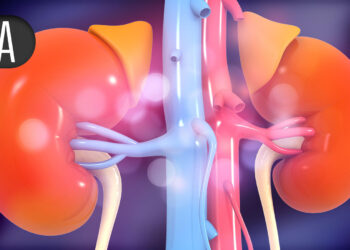TOPLINE:
Children with subclinical hypothyroidism and obesity had lower estimated glomerular filtration rates (eGFRs) and a higher prevalence of kidney damage and hypertension than those without subclinical hypothyroidism, the findings of a preliminary study indicated.
METHODOLOGY:
- Researchers conducted this retrospective study to evaluate the impact of subclinical hypothyroidism on kidney damage in 355 children with obesity (mean age, 10.70 years; 61.6% boys) attending an obesity clinic between January 2021 and January 2024.
- The analysis included routine biochemical assays, oral glucose tolerance test, insulin resistance assessment, and thyroid function tests; the eGFR was calculated using the original Schwartz equation and normalised to the ideal body weight–derived body surface area.
- Kidney damage was defined as the presence of a reduced eGFR (< 90 mL/min/1.73 m2), hypertension, and/or albuminuria (urinary creatinine level ≥ 30 mg/g); 26.7% of the entire cohort had kidney damage.
- Participants were stratified on the basis of the presence of subclinical hypothyroidism, defined as thyroid stimulating hormone serum levels > 4.51 µUI/mL with normal free triiodothyronine and free thyroxine levels; 19.4% of the entire cohort had subclinical hypothyroidism.
TAKEAWAY:
- eGFR values were significantly lower in children with subclinical hypothyroidism than in those without (142.68 vs 162.74 mL/min/1.73 m2; P = .001).
- Children with vs without subclinical hypothyroidism showed a higher prevalence of kidney damage (39.1% vs 20.2%; P = .004) and a more than twofold increase in the risk of developing the condition (odds ratio, 2.04; P = .015).
- Researchers identified an inverse association between thyroid stimulating hormone levels and eGFRs through a general linear model analysis.
- Furthermore, children with subclinical hypothyroidism demonstrated higher rates of hypertension than those without the condition (33.3% vs 19.2%; P = .03).
IN PRACTICE:
“Our study preliminary explored the negative role of SH [subclinical hypothyroidism] on KD [kidney damage] in children with obesity. This might be relevant not only for patients, as it could further exacerbate the already heightened cardiometabolic risk in children with obesity, but also for the healthcare system, since the substantial financial burden associated with CKD [chronic kidney disease],” the authors wrote.
SOURCE:
This study was led by Anna Di Sessa, Department of Woman, Child, and General and Specialized Surgery, University of Campania “Luigi Vanvitelli,” Naples, Italy. It was published online on March 23, 2025, in the International Journal of Obesity.
LIMITATIONS:
The cross-sectional nature of the study prevented establishing a causal relationship between thyroid hormones and kidney damage. Additionally, as a single-centre study conducted in an Italian region with the highest paediatric obesity rate, the patient population may have represented more severely affected cases.
DISCLOSURES:
No sources of funding were provided for this study. The authors reported having no relevant conflicts of interest.
This article was created using several editorial tools, including AI, as part of the process. Human editors reviewed this content before publication.
Source link : https://www.medscape.com/viewarticle/thyroid-dysfunction-can-damage-kidneys-kids-obesity-2025a10007hp?src=rss
Author :
Publish date : 2025-04-01 12:00:00
Copyright for syndicated content belongs to the linked Source.














